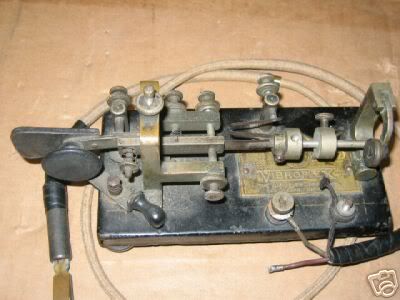My Vibroplex Junior arrived by UPS today, and it's just as described in the auction. I think my $99.99 was very well spent.

The key is missing a weight screw, but is otherwise complete and original with cord. There's still some of the gold pinstriping left, and the original finish still has a luster. Edges along the back and corners show chips. The bottom looks original as well.
It's obvious that this key worked for a living in some capacity or another. All I know is that it came from an estate somewhere in Indiana.
The serial number in the auction was incorrectly read, and I suspected this was so. The serial number in the listing dated it to 1920. If that had been true, the key would have had the old-style “pinned lever” hinge for the dash lever. From the auction listing pics, I could see it had the post-1921 “bent lug” dash lever. No matter though really, as the incorrect digit means it's actually a 1923 key — still quite old and original.
That the key worked for a living is easy to determine. The adjustments screws show much wear. The nickel plating on the frame is worn away from the high-wear areas. The contacts are worn quite thin and the circuit closer shows a good deal of wear. This key was mostly likely used on a telegraph line somewhere.
The key was well packed, and I was pleased to find it undamaged. The adjustments had rattled loose, so I had to readjust the key, but that didn't take long. The key has excellent action. Not bad for an 80-plus year old key.
I also received via UPS another receiver. This one is a Hallicrafters SX-99. Don't ask me why I bought it, nostalgia, I guess. I had a mint SX-100A that I sold too damn cheaply to another local ham. I really want another SX-100, but I don't want to pay the eBay price. The SX-99 was the “Chevrolet” version rather than the “Cadillac.”
I won't take the SX-99 out of the box until tomorrow. My intent is to set it up in the library so I can listen in there while reading at night, or simply enjoying the wood stove.
I'm going to order a book about restoring telegraph keys from a guy whose a real master at it. It's not that I don't think I can do it on my own, but I see value in not reinventing the wheel. I can do the bases, but this guy is using period-correct materials for his stuff, and I think if I do this I would like to keep them period correct. Hell, what's the use of going to the trouble if it's botched?
Of course, I'm going to fix these keys up for me, not for everyone else. But that's the fun of it all. I would love to have a restored 1921 bug on the shack desk, black japanned base with fresh gold pinstripe trim. Yep!
That's it for this installment. My headache is killing me.
73 es CUL … de KY4Z SK …. dit dit ….
UPDATE: Late Thursday night …
After closer examination of the Vibroplex Junior, I've determined that the serial number actually does read as an 80,291 serial number, rather than 89,291. I looked at it a time or two under magnification, and I couldn't figure out the number until I wet it a bit — then the stamping showed up better and confirmed it was the earlier number.
It doesn't really matter that much about the serial number, though it does place the date of manufacture to 1920 rather than 1923. I'm surprised to see the “bent lug” used then, but I guess the company was making the transition to the new style sometime during this year — or the key may have been outfitted with a newer keying lever — a good possibility.
The dash contacts — on both the lever and the post, are very, very worn. The dot contacts appear to be fairly new — not as in new years, but were installed prior to the key falling from general use by the owner(s).
Something else missing on the key is one of the terminal nuts. Nuts! I'll never find an exact replacement for it, either, unless I cannabilize one from another period key.
That's all for this update. More later ….. 73!
